Related Research Articles
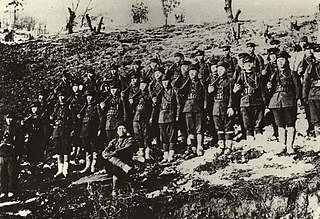
The Battle of Qingshanli was fought over six days in October 1920 between the Imperial Japanese Army and Korean armed groups in a densely wooded region of eastern Manchuria called Qīngshānlǐ. It occurred during the campaign of the Japanese army in Jiandao, during the Japanese rule of Korea (1910–1945).

The Pacification of Manchukuo was a Japanese counterinsurgency campaign to suppress any armed resistance to the newly established puppet state of Manchukuo from various anti-Japanese volunteer armies in occupied Manchuria and later the Communist Northeast Anti-Japanese United Army. The operations were carried out by the Imperial Japanese Kwantung Army and the collaborationist forces of the Manchukuo government from March 1932 until 1942, and resulted in a Japanese victory.

The Northeast Anti-Japanese United Army was the main anti-Japanese guerrilla army in Northeast China (Manchuria) after the Japanese invasion of Manchuria in 1931. Its predecessors were various anti-Japanese volunteer armies organized by locals and the Manchuria branches of the Chinese Communist Party (CCP). In February 1936, the CCP, in accordance with the instructions of the Communist International, issued The Declaration of the Unified Organization of Northeast Anti-Japanese United Army and marked the official formation of the organization.
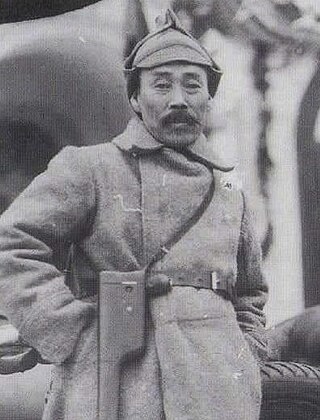
Hong Beom-do was a Korean independence activist and general.
Shin Pal-gyun(신팔균, 申八均, May 19, 1882 ~ July 2, 1924) or Shin Dong-chun was an independence activist of Korea. His wife Im Su-myung (임수명) was an independence activist also.
The Battle of Fengwudong was a battle between Korean independence militias and Japanese forces in Manchuria. It took place between 6 and 7 June 1920, and was one of the earliest domestic support operations of the Korean independence forces. It was a battle in which independence army units defeated the Japanese regular army in Bongo-dong, Manchuria in 1920. The battle began when the independence armies led by Hong Beom-do and Choi Jin-dong attacked and destroyed the Japanese military police border post. The independence army that lured out the Japanese soldiers killed 120 Japanese soldiers and then carried out an operation to continue luring the Japanese soldiers to Bongo-dong. The independence army, which reorganized the combined forces and was in ambush in the Bongo-dong Valley, opened fire all at once when the Japanese army entered the siege, killing 157 Japanese regular soldiers and injuring about 200 others. The reason for this overwhelming victory was the independence army's heightened morale, the commander's foresight, and excellent operational planning.
The Gando massacre was a mass murder committed by the Japanese military against the Korean residents of Gando, after the Hunchun incident.
The Korean invasion of Manchuria was an invasion of Manchuria by the Korean Empire. The attack began on 11 August 1902, when Gojong of Korea sent Yi Bum-yun to Jiandao as an observer. The attack ended in victory for Korea, which gained some control over Jiandao.

The Free City Incident, also known as the Jayu City Incident and the Heukha Incident, occurred on June 28, 1921, in Svobodny in the Far East Republic where the Korean exiled independence fighters who refused to accept command of the Red Army were surrounded and suppressed.

The Korean Independence Army (Korean: 대한독립군) was an independent military force organized in Northern Jiandao (Gando) in 1919 and led by Hong Beom-do, a former gunner. This unit played major roles in defeating the Japanese in the Battle of Fengwudong and Battle of Qingshanli.

The Korean Democratic Corps, also known as the Shinminhoe, Daehan Shinminhoe, or Shinmindan, was a Protestant-affiliated armed independence movement group organized in Vladivostok, Primorsky Krai and East Manchuria in March 12, 1919. It was led by Director Kim Gyu-myeon, Vice Director Han Gwang-taek, General Affairs Director Choi Sang-jin, Finance Director Lee Jon-su, and Foreign Affairs Director Kim Deok-bo were appointed.

The Northern Military Administration Office (Korean: 북로군정서) was an armed independence movement group founded in Donggandao in 1919. It originated from the Daejonggyo lineage. It was organized around Seo Il and Kim Jwa-jin in Jilin Province, Manchuria, in 1919. Based on the Junggwangdan organized by Koreans who immigrated to Bukgando, the Jeongjeongdan organized in Bukgando in 1919 was established by changing its name to Northern Military Administration Office. The Northern Military Administration Office established an officer training center to conduct military training and train independence fighters. In 1920, when Japan deployed its troops into Manchuria, it achieved a great victory over the Japanese army in the Battle of Cheongsanri.

The Korean Northern Army Command (Korean: 대한북로독군부) was a union of militant independence groups formed by Hong Beom-do's Korean Independence Army, Cho An-mu's Korean National Army, and Choi Jin-dong's Military Affairs Command in May 1920, and played a leading role in winning the Battle of Fengwudong in June 1920.
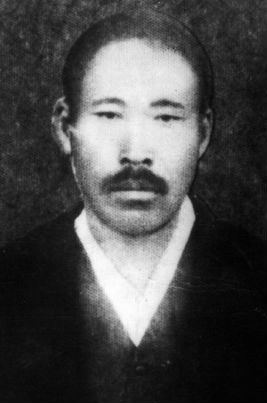
Hyeon Ik-cheol was a teacher and an independence activist who served as chairman of the Tongui Department during the Japanese Occupation of Korea, chairman of the central executive committee of the National People's Prefecture, and central executive secretary of the Korean Revolutionary Party, and member of the Military Studies Compilation Committee of the Provisional Government of the Republic of Korea.
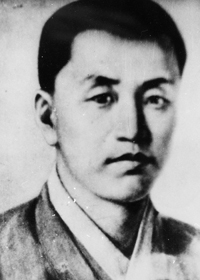
Yang Se-bong was a Korean independence activist and the commander-in-chief of the Korean Revolutionary Army of the National People's Prefecture, during the Japanese colonial period. General Yang Se-bong has joined several independence organization training and leading resistance fighters against the Japanese military and police in Manchuria and Korea. Yang Se-bong was a leader who was transcendent, who warmly embraced the mistakes of his subordinates and did not criticize them under any circumstances. Yang posthumously received the recipient of the Order of Merit for National Foundation.

The Korean Unification Government (Korean: 대한통의부), previously known as the Unification Military Government, was an independence movement group organized in Manchuria in February 1922 by integrating several independence movement groups active in the West Jiandao region. The Unification Government expanded and reorganized into the Korean Unification Government in August 1922, which was established as the first integrated independence army organization in West Jiandao and revitalized the activities of the independence army, which had been in a temporary stagnation, under the banner of Daedong unity. They carry out the anti-Japanese independence movement more effectively at the South Manchurian Unification Association held in Magwonja, Nam-gu, Hwanin-hyeon, Bongcheon-province. The Korean Unification Government carried out autonomous activities such as education and industry promotion and various armed struggle activities in the West Jiandao region. Due to its nature as a union of various organizations with different backgrounds, a division occurred, and it was divided into the reformed Righteous Army Command, General Staff Headquarters, and Righteous Government.

The Righteous Army Command (Korean: 의군부) was a monarchist independence movement group organized in Manchuria in 1919. Their military foundation was based on the former Righteous Army fighters who escaped to Manchuria after failing to retake Seoul from the Japanese Empire. They were known for fighting alongside militant independence groups at several major battles against the Japanese. When they joined the Korean Unification Government, they came into conflict with them due to ideological differences between monarchism and republicanism which led to several bloody conflicts. Eventually they withdrew from the government to establish themselves as an autonomous organization, but due to the rise in democracy and socialism their power waned and they disbanded to joined the other autonomous organizations.
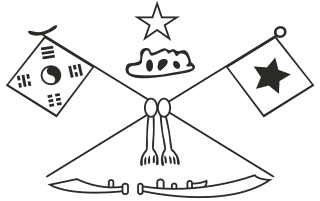
The Patriotic Blood Corps also known as the Korean Patriotic Youth Blood Corps was an anti-Japanese armed group organized in Chupung, Primorsky Krai, Russia in 1920. It was founded by Kang Guk-mo, Kim Jong-hwa, and others based on members of the Korean Independence Corps who had moved from Western Jiandao. Chae Young (蔡英) was appointed commander and won the battle against the Japanese army in June 1920. In October 1920, it moved to Annuchino and integrated with the Sucheong army and the New People's Unit, but returned to Chupung in the fall of 1921.

The Korean Righteous Military Administration Office was an organization organized by former Korean soldiers and volunteer soldiers who had been directly fighting against the Japanese army with weapons in the country since before the March 1st Movement in 1919. They joined the Korean Independence Corps as the Korean Volunteer Army but was later disbanded due to the Free City Incident.
References
- 1 2 3 4 5 6 7 8 Esselstrom, Erik W. (2005). "Rethinking the Colonial Conquest of Manchuria: The Japanese Consular Police in Jiandao, 1909-1937". Modern Asian Studies. 39 (1): 39–75. doi:10.1017/S0026749X04001398. JSTOR 3876506. S2CID 145309281.
- 1 2 Kang Man-gil, 1994, A History of Contemporary Korea (United Kingdom: Global Oriental) p. 35.
- ↑ Michael E. Robinson, 2007, Korea’s Twentieth-Century Odyssey: A Short History (Honolulu: University of Hawaii Press).
- 1 2 Kang Man-gil, 1994, A History of Contemporary Korea (United Kingdom: Global Oriental) p. 36.
- 1 2 "Text of Bryce EUlogies and Statement on Siberia" (PDF). The New York Times. 24 January 1922. Retrieved 13 June 2018.
- 1 2 Kang Man-gil, 1994, A History of Contemporary Korea (United Kingdom: Global Oriental) p. 37.
- ↑ "North Korea criticizes Japan's 'punitive operations' in 1920". BBC Monitoring Asia Pacific. 2 October 2009. ProQuest 460755521.
- ↑ “Koreans Charge Cruelty,” New York Times, 24 December 1920, https://timesmachine.nytimes.com/timesmachine/1920/12/24/103519339.pdf
- ↑ Kang Man-gil, 1994, A History of Contemporary Korea (United Kingdom: Global Oriental) pp. 33-34.
- ↑ "Korea - History - the Independence Army".
- ↑ 陸軍第十九師團司令部 「間島事件鮮支人死傷者調」 大正十年二月二十五日